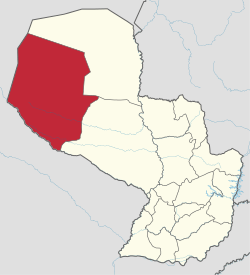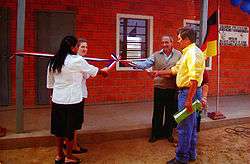Boquerón department
Boquerón (Spanish pronunciation: [bokeˈɾon]) is a department in the western region of Paraguay. It is the country's largest department, with an area of 91,669 km2 (35,394 sq mi), but its population is only 45,617 (2002 census). The department includes the Russian Mennonite colonies of Fernheim, Menno and its administrative center Loma Plata and Neuland. The capital is Filadelfia. Other towns are General Eugenio A. Garay, Doctor Pedro P. Peña and Mariscal Estigarribia.
Boquerón Department | |
|---|---|
 Flag Coat of arms | |
 | |
| Coordinates: 21°31′S 60°42′W | |
| Country | |
| Capital | Filadelfia |
| Number of Districts | 3 |
| Government | |
| • Governor | Edwin Pauls Friesen (ANR) |
| Area | |
| • Total | 91,669 km2 (35,394 sq mi) |
| Population (2002) | |
| • Total | 45,617 |
| • Density | 0.50/km2 (1.3/sq mi) |
| Time zone | UTC-04 (AST) |
| • Summer (DST) | UTC-03 (ADT) |
| ISO 3166 code | PY-19 |
The western region—Paraguay Occidental—with two percent of the Paraguayan population, produces nearly 65% of the country's milk and meat. High agricultural output is linked to the advanced technology and industry of the Mennonite settlements.
In 1945 Boquerón was split, with the portion separated off being renamed "Chaco". The reduced remaining area continued to be called "Boquerón", and the department's capital was moved to Filadelfia (the previous capital had been Doctor Pedro P. Peña). However, in 1992 the previous department Chaco was re-integrated into Boquerón, effectively re-forming the department as of 1945 when it was split, except that after 1992 the enlarged department's capital remained at Filadelfia.
Geography
Boquerón Department is located in the Occidental Region of Paraguay, between the southern parallels 20° 06' and 23° 50' of latitude, and the western meridians 50° 20' and 62° 40' of longitude.
Adjacent territories
North: Alto Paraguay Department, separated by an imaginary straight line that goes from Hito IV Fort Tte. G. Mendoza to Fort Madrejón; and also by a railway from "km 220" to "km 160".
South: Argentina, separated by the Pilcomayo River, from Misión San Lorenzo to Hito I Esmeralda.
East: Presidente Hayes Department, separated by the road that connects Misión San Lorenzo with Fort Gral. Díaz, Ávalos Sánchez, Zenteno, Dr. Gaspar Rodríguez de Francia, Boquerón, Isla Po'í and Casanillo; and from this point, by an imaginary straight line until "km 160". It also borders Alto Paraguay Department, separated from it by a straight imaginary line from Fort Madrejón to Fort Carlos Antonio López and from there by another line to Fort Montanía.
West: Bolivia, separated by an imaginary line from Hito I Esmeralda until Hito IV Fort Tte. Gabino Mendoza.
Natural environment
This is the most deserted region of Paraguay; it has some small streams, but with dry riverbeds. The rain is scarce but when it does rain, it causes inundations. It rains about 350 mm a year in the north of the department and 850 mm a year in the south.
The trees in the area are short and thorny; there are brushwood and cactus, dunes and small hills, especially in the north of the department. Some species of trees in this region are in danger of extinction: the urunde'y, white and red quebracho, samu'u also known as palo borracho and palo santo.
Climate
The average temperature is 25 °C. The average annual precipitation is 400 mm. Boquerón is also called Alto Chaco or Dry Chaco and in summer registers the highest temperatures in the country.
Demographics
Boquerón presently experiences the country's greatest rate of population increase, about 12.4% annually. This department is characterized by its native population, the Mennonites, the Paraguayans, the Brazilians and other foreign residents in the country.
The National Census in 2002 registered 45,617 people living in Boquerón, mostly Native Americans (19,945, or 43.7%, distributed in the following ethnic groups: Nivaclé, Manjui, Guarayos, Angaité, Ayoreos, Guaraní-Ñandéva, Tapieté and Toba-Maskóy). The majority of Paraguay's native population lives in this department.
Population
The total Native population of the country is 87,099. The quantity in Chaco is 42,939. The total Boquerón population is 45,617, 19,945 of which are natives. Growth of the total population in Boquerón is 4.6% and in the Urban area alone is 12.4%.
- Filadelfia: 7,750
- Loma Plata: 6,500
- Yalve Sanga: 4,200
- Mariscal Estigarribia: 2,000
- Neu-Halbstadt: 720
- Choferes del Chaco: 600
District and departmental governments
The department is divided in 6 districts:
Boquerón had only one district since December 18, 1944. In December 2006, Loma Plata and Filadelfia were added, and this last became the new capital of the department by Law 71/92. Boquerón now has 4 members and 40 councilors in the executive government. It is expected Neuland Colony will become a new district in the future. Most recently, a few new districts were added, which consist of the following: General E. A. Garay, Doctor P. P. Peña and New Land.
The current governor of the department is David Sawatzky. The mayor of Mariscal Estigarribia is Eladio Alcaraz, the mayor of Filadelfia is Hermann Ratzlaff and the mayor of Loma Plata is Ernst Giesbrecht.
The government of the department administers two high schools, one agricultural school, a hospital and the Hydrological Resources Director (DRH for its initials in Spanish), that belongs to the Agriculture and Cattle Ministry. It has a Health and Education Secretary, a Natural Environment Secretary, a Secretary for Native-American Related Affairs, Public Construction, Women Related Affairs, Childhood and Youth Secretaries.
Education
The department has 160 educational institutions with 9,000 students and more than 450 teachers. These numbers include the private institutions and the one that provides professional skills education. Literacy instruction reaches 80%, according to the Census of 2002.
Distance is the main challenge for both students and teachers; it is hard sometimes to get to the educational institutions and because of that people drop out of school. There are some marginal areas with well-defined curricular norms set by the Occidental Region, but there are not enough teachers for the classes.
The total registered students is 8,932: 6,689 in elementary school and 2,243 in high school in a total of 103 schools. There are 384 registered teachers.
The literate population of 15 years and more is 21,482.
Health
This department has 4 private hospitals; the 17th Health Region, assisted by the Ministry of Public Health and Social Wellbeing, has a regional hospital in Mariscal Estigarribia; the government supports the Maternal and Childhood Center in Villa Choferes del Chaco. More than half of the population is in Filadelfia, Loma Plata, Yalve Sanga and Colonia Neuland.
The natives receive health care from the private sector. Some of them have Social Security, but not all. In this department are 23 health centers, which have 8.8 beds per 10,000 inhabitants.
Mennonites have private medical insurance and are well-organized in that sector. The health system is a basic necessity and is the one that needs more attention, considering that 22% of the population in the area lives in poverty.
Economy
Cattle raising generates the greatest share of the income, with the dairy products and meat being exported. There are 4,500 owners of 900,000 cows. The area's daily dairy production is about 450,000 to 500,000 liters of milk; this forms 70% of the industry in the Central Chaco.
Leatherworking is a considerable portion of the local economy, with saddles and shoes the main products. In agriculture, the common products are: bananas, lemons, sweet and sour oranges, tangerines, beans, sweet potatoes, onions, pumpkins, corn, peanuts and sorghum.

Communications
Boquerón has 120 kilometers of paved roads but also many that are not paved, which makes travel difficult in the rainy and dry seasons.
Traveling to this region has its inconveniences; people who do must foresee the logistic aspects such as taking with them drinking water, food, enough fuel, and an emergency kit.
The labor of the Mennonites is remarkable because they maintain the roads they use by themselves with their own resources; this includes work on about 3,800 kilometers of road every year. They also know the region very well.
The Mariscal Estigarribia district has an airport used by all kinds of planes.
In some districts, modern technology such as television, internet and cell phones are available. Nevertheless, there are places where communication is impossible because of the characteristics of the land. In addition most of the Ayoreo natives who still live in the interior have not yet adapted to civilization.
Radio stations serve a fundamental role as a means of communication. La Voz del Chaco Paraguayo AM, broadcasts to the entire Occidental Region, reaching places where communication is usually difficult.
There is another radio station, Radio Médano, which broadcasts in FM.
There are two community radio stations: one in Mariscal Estigarribia and another in Doctor Pedro P. Peña.
Tourism
Rural and ecological tourism has become very popular in the Central Chaco, where people can witness the life and process of adaptation of the colonial immigrants. Many tourists and students visit the native villages and colonies that are dedicate to cattle and some other industries; most of them leave very pleased by the experience.
The Boquerón, Toledo and Isla Po'í forts are very popular; in these places, traces remain of the Chaco War, an important part of Paraguayan history.
Symbols
Boquerón has a flag and badge. The musical theme Chaco Boreal is the anthem of the department. These symbols were presented in public on September 29, 1995, in Fort Toledo, in the presence of 200 students of the area.
References
| Wikimedia Commons has media related to Boquerón Department. |
- Geografía del Paraguay - Editorial Hispana Paraguay S.R.L.- 1a. Edición 1999 - Asunción Paraguay
- Geografía Ilustrada del Paraguay - ISBN 99925-68-04-6 - Distribuidora Arami S.R.L.
- La Magia de nuestra tierra. Fundación en Alianza. Asunción. 2007.